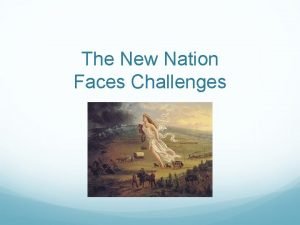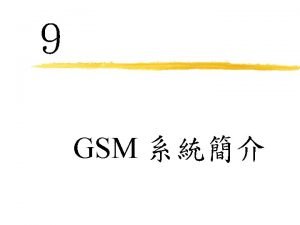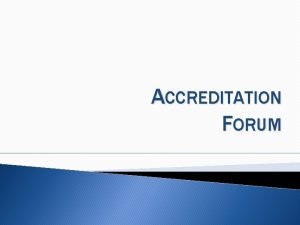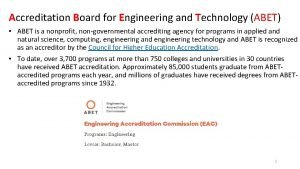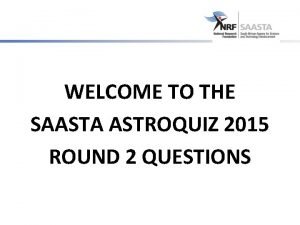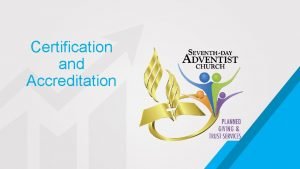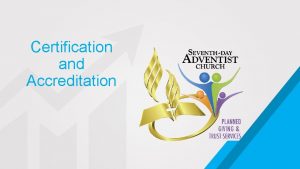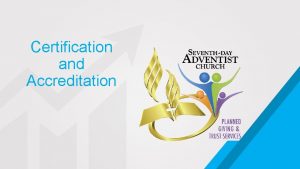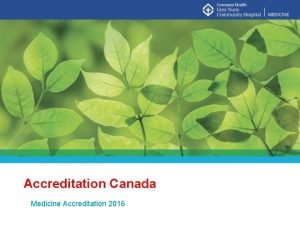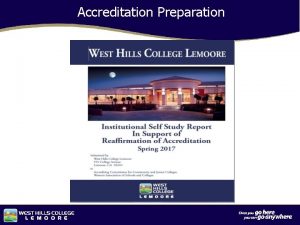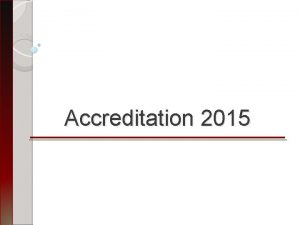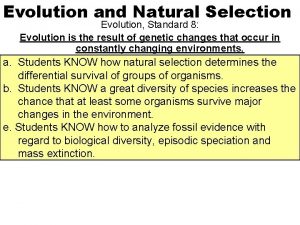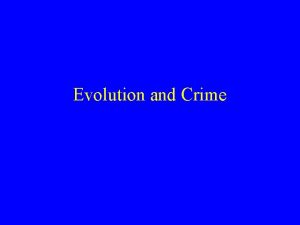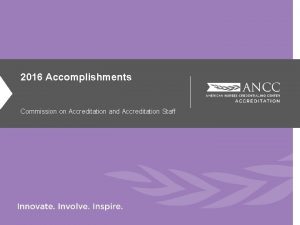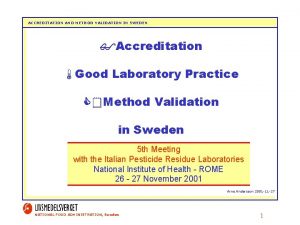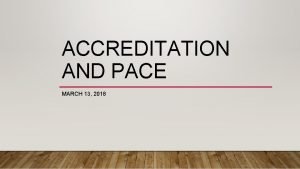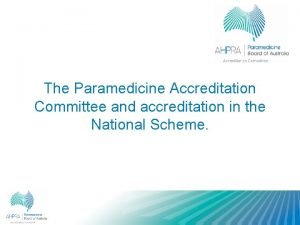2015 Accreditation Institute Accreditation Evolution and New Challenges




















- Slides: 20

2015 Accreditation Institute Accreditation: Evolution and New Challenges Constance M. Carroll, Ph. D. Chancellor San Diego Community College District 1

Accreditation and Quality Assurance in Other Countries Government Minister/Secretary of Education Higher Education Councils 2

Types of Accreditation There are two basic types of educational accreditation: Institutional accreditation normally applies to an entire institution. Specialized or programmatic accreditation normally applies to programs, departments, or schools that are parts of an institution, generally specialized or vocational programs 3

Types of U. S. Accrediting Organizations There are four types of accrediting organizations: Regional accreditors National faith-related accreditors National career-related accreditors Programmatic accreditors 4

Major Federal Legislation Affecting Accreditation 1952 1965 Veterans Readjustment Assistance Act - expands GI Bill funding and establishes nongovernmental accreditors as “reliable authorities” as to quality of educational offerings. Higher Education Act - establishes the basic structure for ongoing grant and loan programs for students. 1972 Major expansion of federal student aid, including making funds available to students attending for-profit institutions and affirming that federal assistance is to go to students and not institutions. 1992 Federal oversight of accreditation incorporated into the Higher Education Act, in part a reaction to concerns about the extent to which students were defaulting on federal loans. 5

History of U. S. Accreditation 1880 s First regional accrediting agencies are formed 1912 The National Association of Accredited Commercial Schools, the first national accrediting agency, is formed 1948 Western College Association is formed 1950 s Expansion of public sector higher education beyond teacher education to multi-purpose state colleges and universities and establishment of thousands of community colleges; periodic review, site visits, and the use of self-studies begin to emerge among accrediting agencies 6

Six Regional Accrediting Organizations Northwest (includes Alaska) Western (includes Hawaii) North Central New England Middle States Southern http: //www. macu. edu/about-macu/accreditation. html 7

Number of Institutions Accredited by Regional Accrediting Organizations The Western Association of Schools and Colleges (WASC) is the only regional accrediting organization that has two higher education accreditors: the Accrediting Commission for Community and Junior Colleges (ACCJC) and the Accrediting Commission for Senior Colleges and Universities (SCUC) 8

Who Accredits the Accreditors? Accrediting organizations are accountable to the institutions and programs they accredit They are also required to have “recognition” by the United States Department of Education (USDE) in order to be eligible for federal student aid and other programs Although accreditation is a nongovernmental activity, recognition is a governmental function 9

Functions of Accreditation serves several major purposes: Assuring quality Access to federal and state funds Engendering public confidence Facilitating transfer 10

Accreditation Process 1. Standards Established 2. Comprehensive Self-Study/ Self-Evaluation 3. Site Visit/On-site Evaluation 4. Judgment by Accrediting Organization 5. Midterm Reports 6. Annual Reports 7. Substantive Change Image from ACCJC/WASC presentation “Accreditation and Trustee Roles and Responsibilities” 11

Basic Eligibility Requirements for Community Colleges 1. Authority (license) to operate 2. Operational Status 3. Degree Programs 4. Chief Executive Officer (full-time) 5. Financial Accountability • • including external audits including GASB requirements 12

Basic Eligibility Requirements for Community Colleges (cont’d) 6. Mission 7. Governing Board (independent) 8. Administrative Capacity 9. Educational Programs 10. Academic Credit 11. Student Learning and Student Achievement 12. General Education 13. Academic Freedom 13

Basic Eligibility Requirements for Community Colleges (cont’d) 14. Faculty 15. Student Support Services 16. Admissions 17. Information and Learning Support Services 18. Financial Resources • integrated with all planning 19. Institutional Planning and Evaluation 20. Integrity in Communication with the Public 21. Integrity in Relations with the Accrediting Commission 14

Standards of Accreditation Standard I: Mission, Academic Quality and Institutional Effectiveness, and Integrity Standard II: Student Learning Programs and Support Services Standard III: Resources Standard IV: Leadership and Governance 15

Major Changes to ACCJC Standards 1996 Introduction of Student Learning Outcomes (SLOs), focus on institutional effectiveness 2002 Consolidation of ten standards to four; expansion of “culture of evidence” 2014 Addition of requirements for institutions offering baccalaureatelevel programs 16

ACCJC Bachelor’s Degree Requirements ACCJC authorized to approve bachelor’s degrees through the substantive change process Added to draft standards new requirements specific to bachelor’s degree Minimum 120 semester credits Minimum GE requirement 36 semester credits All standards apply and interpreted in the context of the degree (e. g. faculty credentials, library resources, etc. should be appropriate to the degree) Substantive Change Process 17

Accreditation Actions 1. Candidacy (grant, extend, deny) 2. Initial Accreditation (grant, follow-up, extend, deny) 3. Reaffirm (defer, follow-up reports, and/or visits) 4. Warning 5. Probation 6. Show Cause 7. Terminate 8. Restoration Status 18

Future Directions/Challenges Role of ACCJC - CCC Board of Governors Meeting 1/20/15 19

THANK YOU! Q and A 20
 Education for all 2000 2015 achievements and challenges
Education for all 2000 2015 achievements and challenges The new nation faces challenges
The new nation faces challenges New jersey institute for continuing legal education
New jersey institute for continuing legal education Etsi
Etsi New york pennsylvania new jersey delaware
New york pennsylvania new jersey delaware Fresh oil new wine
Fresh oil new wine Weaknesses and strengths of the articles of confederation
Weaknesses and strengths of the articles of confederation Marketing kotler keller
Marketing kotler keller New classical macroeconomics
New classical macroeconomics Chapter 16 toward a new heaven and a new earth
Chapter 16 toward a new heaven and a new earth Both new hampshire and new york desire more territory
Both new hampshire and new york desire more territory New classical and new keynesian macroeconomics
New classical and new keynesian macroeconomics National board of accreditation questions and answers
National board of accreditation questions and answers Accreditation board for engineering and technology
Accreditation board for engineering and technology Opportunities media and information
Opportunities media and information Split speech punctuation
Split speech punctuation Marquee orchard 14
Marquee orchard 14 New-old approach to creating new ventures
New-old approach to creating new ventures Njbta
Njbta Roosevelt vs taft progressivism venn diagram
Roosevelt vs taft progressivism venn diagram Saasta astro quiz 2015 questions and answers
Saasta astro quiz 2015 questions and answers

